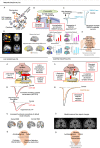Cognitive impact of neuronal antibodies: encephalitis and beyond
- PMID: 32873782
- PMCID: PMC7463161
- DOI: 10.1038/s41398-020-00989-x
Cognitive impact of neuronal antibodies: encephalitis and beyond
Abstract
Cognitive dysfunction is a common feature of autoimmune encephalitis. Pathogenic neuronal surface antibodies are thought to mediate distinct profiles of cognitive impairment in both the acute and chronic phases of encephalitis. In this review, we describe the cognitive impairment associated with each antibody-mediated syndrome and, using evidence from imaging and animal studies, examine how the nature of the impairment relates to the underlying neuroimmunological and receptor-based mechanisms. Neuronal surface antibodies, particularly serum NMDA receptor antibodies, are also found outside of encephalitis although the clinical significance of this has yet to be fully determined. We discuss evidence highlighting their prevalence, and association with cognitive outcomes, in a number of common disorders including cancer and schizophrenia. We consider mechanisms, including blood-brain barrier dysfunction, which could determine the impact of these antibodies outside encephalitis and account for much of the clinical heterogeneity observed.
Conflict of interest statement
The authors declare that they have no conflict of interest.
Figures

References
-
- Schmidt-Wilcke T, et al. GABA-from inhibition to cognition: emerging concepts. Neuroscientist. 2018;24:501–515. - PubMed
-
- Kornau HC, et al. Human cerebrospinal fluid monoclonal LGI1 autoantibodies increase neuronal excitability. Ann. Neurol. 2020;87:405–418. - PubMed
-
- Kreye J, et al. Human cerebrospinal fluid monoclonal N-methyl-D-aspartate receptor autoantibodies are sufficient for encephalitis pathogenesis. Brain. 2016;139:2641–2652. - PubMed
Publication types
MeSH terms
Substances
LinkOut - more resources
Full Text Sources
Medical

